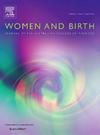妊娠和极端高温事件:快速审查与健康结果、风险因素和干预措施有关的证据
IF 4.1
2区 医学
Q1 NURSING
引用次数: 0
摘要
气候变化正在增加极端高温事件(EHEs)的频率和严重程度,导致脆弱人群的发病率和死亡率增加。孕妇和胎儿面临EHEs不良妊娠结局的风险。目的整理和综合EHE对孕妇和胎儿的影响及相关缓解因素和干预措施的现有证据,为卫生保健提供者和其他关注妊娠的受众提供信息。方法采用同行评审检索策略,在MEDLINE、EMBASE、Global Health、CAB Abstracts、SCOPUS和ProQuest Public Health等数据库中检索2009 - 2023年发表的英、法文实证研究和综述。搜索策略集中在与EHEs、暴露和怀孕相关的术语上。审查并叙述了与EHEs(根据高环境温度阈值定义)有关的健康结果、风险因素和干预措施。结果纳入68项研究(n = 16篇综述;N = 52项实证研究)。确定了不良胎儿结局(如早产)和孕产妇结局(如严重的孕产妇发病率)与EHEs之间的关联。研究发现,社会经济地位较低的孕妇更容易发病。研究人员提出了改善临床医生支持等干预措施,以降低不良妊娠结局的风险。结论EHEs与妊娠相关发病率和死亡率的发展存在相关性,其介导因素包括环境、社会和个体内在因素。已经确定的知识差距仍有待解决,但更重要的是,综合这些证据突出表明,迫切需要采取干预措施,例如改进医疗保健提供者的教育,并采取政策干预措施,以减轻孕妇暴露在高温下造成的健康风险。本文章由计算机程序翻译,如有差异,请以英文原文为准。
Pregnancy and extreme heat events: A rapid review of evidence related to health outcomes, risk factors and interventions
Background
Climate change is increasing the frequency and severity of extreme heat events (EHEs), resulting in increased morbidity and mortality for vulnerable populations. Pregnant people and fetuses are at risk for adverse pregnancy outcomes from EHEs.
Objective
To collate and synthesize existing evidence on the effects of EHE on pregnant people and fetuses and relevant mitigating factors and interventions to inform healthcare providers and other pregnancy-focused audiences.
Methods
A peer-reviewed search strategy was conducted in MEDLINE, EMBASE, Global Health, CAB Abstracts, SCOPUS, and ProQuest Public Health, for empirical studies and reviews published between 2009 and 2023 in English and French. The search strategy focused on terms related to EHEs, exposure, and pregnancy. Health outcomes, risk factors and interventions relating to EHEs (defined based on high ambient temperature thresholds) were reviewed and narratively reported.
Findings
Sixty-eight studies were included (n = 16 reviews; n = 52 empirical studies). Associations between both adverse fetal outcomes (e.g., pre-term birth) and maternal outcomes (e.g., severe maternal morbidities) and EHEs were identified. Pregnant people with low socioeconomic status were found to be more likely to have morbidities. Interventions such as improved clinician support have been proposed by researchers to reduce the risk of poor pregnancy outcomes.
Conclusion
There is an association between EHEs and the development of pregnancy-related morbidity and mortality, mediated by environmental, social and intrinsic individual factors. There are remaining knowledge gaps that have been identified that should be addressed, but more importantly, the synthesis of this evidence highlights the urgent need for interventions such as improved healthcare provider education, and policy interventions to mitigate the health riskscaused by exposure to heat in pregnant populations.
求助全文
通过发布文献求助,成功后即可免费获取论文全文。
去求助
来源期刊

Women and Birth
NURSING-OBSTETRICS & GYNECOLOGY
CiteScore
7.20
自引率
13.20%
发文量
371
审稿时长
27 days
期刊介绍:
Women and Birth is the official journal of the Australian College of Midwives (ACM). It is a midwifery journal that publishes on all matters that affect women and birth, from pre-conceptual counselling, through pregnancy, birth, and the first six weeks postnatal. All papers accepted will draw from and contribute to the relevant contemporary research, policy and/or theoretical literature. We seek research papers, quality assurances papers (with ethical approval) discussion papers, clinical practice papers, case studies and original literature reviews.
Our women-centred focus is inclusive of the family, fetus and newborn, both well and sick, and covers both healthy and complex pregnancies and births. The journal seeks papers that take a woman-centred focus on maternity services, epidemiology, primary health care, reproductive psycho/physiology, midwifery practice, theory, research, education, management and leadership. We also seek relevant papers on maternal mental health and neonatal well-being, natural and complementary therapies, local, national and international policy, management, politics, economics and societal and cultural issues as they affect childbearing women and their families. Topics may include, where appropriate, neonatal care, child and family health, women’s health, related to pregnancy, birth and the postpartum, including lactation. Interprofessional papers relevant to midwifery are welcome. Articles are double blind peer-reviewed, primarily by experts in the field of the submitted work.
 求助内容:
求助内容: 应助结果提醒方式:
应助结果提醒方式:


